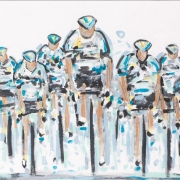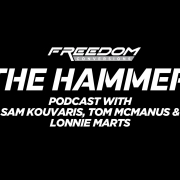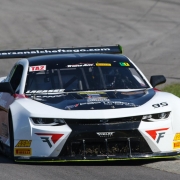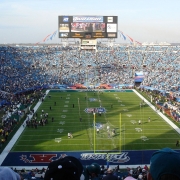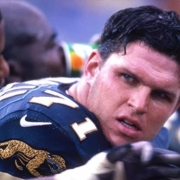Sports Art from a Local Artist
It wasn’t until Heather Blanton had what she jokingly calls a “midlife crisis” that she became a painter.
She was about to turn 40.
The recession had hit. And her medium for more than 10 years — Polaroid manipulation photography — was on its way out.
“I needed to find something,” she said, standing in front of some of her work at the Plum Gallery in St. Augustine.
Although she played softball in middle and high school, sports was never really her focus. She watched football and baseball with her father, but she was never much of a spectator.
Still, the St. Augustine resident found her artist’s inspiration in an unexpected outlet: through those on fields of play.
“I have a twin sister who is an artist,” Blanton said. “She encouraged me a lot. She said, ‘I know you can paint. You just have to let go of your fear, and magical things will start happening.’ And they did.”
About five years ago, Blanton put brush to canvas for a commission from a cyclist who wanted original artwork around his sport. And that’s how it started.
Sitting in front of a blank canvas, the Sandalwood High graduate started creating cyclists as she saw them in her memory.
“I lived in Vilano Beach, and I would take A1A on Sundays to see my family,” she said. “I would get behind about 45 cyclists. So rather than be upset about being stuck in traffic, I tried to be grateful for all the colors that were in front of me.”
Blanton was less interested in the art being abstract or realistic, but more about conveying the energy she saw on the road onto the canvas.
“I try to not do too much planning because I’ve found that it’s better to allow the energy of the painting to move through me rather than a preconceived idea,” she said of her process. “I ask for some divine intervention to come and help me with a piece.”
There’s an organized randomness to her paintings. It’s not haphazard by any means, but there is a sense of what’s going on in that moment.
All of that inspiration, despite having no experience running, skiing, playing golf or cycling.
“I’ve never been on anything but a beach cruiser, usually with a drink holder on the front,” she said with a laugh.
From cycling, Blanton branched out to other sports, such as painting marathoners.
“There was just a calling to me about the mass numbers of runners. The marathon can be consistently chaotic,” she said. “I got a lot of feedback from people. ‘You don’t have the energy. Marathons are about chaos.’ So I tried to have more chaos in the feel.”
Most of her paintings come in one sitting, and if there’s a theme in any of Blanton’s work, a triangle makes its way into a lot of her paintings.
It can be seen in the form of golfers taking swings or snowboarders going for rides.
“It’s gone to some kind of geometrical form for me. I’m not sure why, but there’s something interesting about the lines for me,” she said. “It doesn’t have any real meaning besides that’s how I see it. I try to paint stuff I like and hope other people do. If you try to paint towards what other people want, I think you make yourself crazy.”
Others have found enjoyment in her work.
From a commercial standpoint, the Gaylord Marriott in Denver took her sixth painting of skiers and used it in 159 public spaces and common areas in the hotel. She is in numerous galleries all over the U.S., as well as overseas.
Blanton has met with the PGA Tour about doing some work when they open their new global headquarters in Ponte Vedra.
She and her twin sister, Holly, have collaborated on about 10 sports paintings and have sold them at the Saatchi Gallery in London. They’ve talked with Porsche about murals in their worldwide headquarters and would like to talk to the Jaguars about some of the collaborative work they’ve done that depicts football.
One shows a line of football players over an abstract background. “My sister did the background, and I came back over on top of it,” Heather said.
There are numerous colors and uniforms represented and plenty more than 11 players depicted.
“That’s not a line,” she said of the line of players across the center of the painting, “that’s more abstract. It’s not realism. Art is open to interpretation. It’s not about following rules. I’ve never been much on following rules.”
Said Holly: “Heather has the potential to be famous. There’s not a lot of images that come to mind when you think of sports fine art. There’s nobody else doing what she’s doing.”
Heather refers to her process as an “experience beyond words,” which gets her started and carries her through a project.
It can be a daunting feeling in front of a blank canvas, but she believes she’s as much of a “channeler” as a creator.
“The paintings I love the most take me the least amount of time,” she said. “When you are in that zone, when you go back to paintings, they don’t have that same magic. I try to do them all in one sitting. I almost feel a singing inside of me. It’s almost a harmonic.”
Often, even she is amazed when a work is complete.
“I don’t feel responsible for the finished product,” she said. “Sometimes, I stand back and just go, ‘Wow,’ I never would have come up with that.”

